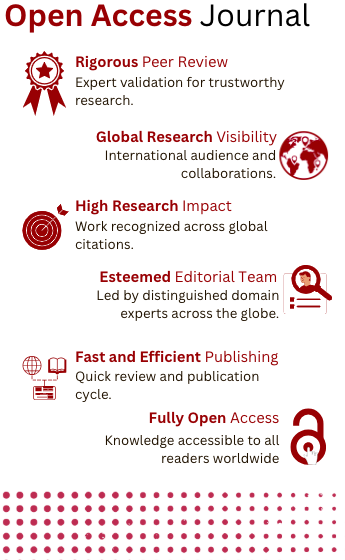Credit Card Fraud Detection Using Hidden Markov Model
Keywords:
Hidden Markov Models (HMMs), online shopping, credit card security, e-commerce fraud detectionAbstract
There has been a remarkable growth in the use of credit cards in recent years. If you're shopping online or in person, you're more likely to be targeted by fraudsters who use credit cards. Using a Time in homogeneous hidden Bernoulli model (THBM), we demonstrate how this model may be utilised to identify fraud in credit card transaction processing. At the beginning of its training process, an HMM learns from the typical behaviour of a cardholder. If the prepared HMM rejects an approaching Visa exchange with an adequately high likelihood, it is viewed as deceitful. Simultaneously, we work to ensure that authentic exchanges are not rejected. In order to demonstrate the efficacy of our method and compare it to other strategies accessible in the literature, we conduct extensive experiments.
References
Syeda, M., Zhang, Y. Q., & Pan, Y. (2002, May). Parallel granular neural networks for fast credit card fraud detection. In 2002 IEEE World Congress on Computational Intelligence. 2002 IEEE International Conference on Fuzzy Systems. FUZZ-IEEE'02. Proceedings (Cat. No. 02CH37291) (Vol. 1, pp. 572-577). IEEE.
Stolfo, S., Fan, D. W., Lee, W., Prodromidis, A., & Chan, P. (1997, July). Credit card fraud detection using meta-learning: Issues and initial results. In AAAI-97 Workshop on Fraud Detection and Risk Management (pp. 83-90).
Stolfo, S. J., Fan, W., Lee, W., Prodromidis, A., & Chan, P. K. (2000, January). Cost-based modeling for fraud and intrusion detection: Results from the JAM project. In Proceedings DARPA Information Survivability Conference and Exposition. DISCEX'00 (Vol. 2, pp. 130-144). IEEE.
Kim, M. J., & Kim, T. S. (2002, August). A neural classifier with fraud density map for effective credit card fraud detection. In International conference on intelligent data engineering and automated learning (pp. 378-383). Springer, Berlin, Heidelberg.
Sreedhar Kumar, S., Ahmed, S. T., & NishaBhai, V. B. Type of Supervised Text Classification System for Unstructured Text Comments using Probability Theory Technique. International Journal of Recent Technology and Engineering (IJRTE), 8(10).
Ahmed, S. T., Singh, D. K., Basha, S. M., Abouel Nasr, E., Kamrani, A. K., & Aboudaif, M. K. (2021). Neural network based mental depression identification and sentiments classification technique from speech signals: A COVID-19 Focused Pandemic Study. Frontiers in public health, 9, 781827.
Chan, P. K., Fan, W., Prodromidis, A. L., & Stolfo, S. J. (1999). Distributed data mining in credit card fraud detection. IEEE Intelligent Systems and Their Applications, 14(6), 67-74.
Brause, R., Langsdorf, T., & Hepp, M. (1999, November). Neural data mining for credit card fraud detection. In Proceedings 11th International Conference on Tools with Artificial Intelligence (pp. 103-106). IEEE.
Chiu, C. C., & Tsai, C. Y. (2004, March). A web services-based collaborative scheme for credit card fraud detection. In IEEE International Conference on e-Technology, e-Commerce and e-Service, 2004. EEE'04. 2004 (pp. 177-181). IEEE.
Prodromidis, A. L., & Stolfo, S. (1999). Agent-based distributed learning applied to fraud detection.
Phua, C., Alahakoon, D., & Lee, V. (2004). Minority report in fraud detection: classification of skewed data. Acm sigkdd explorations newsletter, 6(1), 50-59.
Vatsa, V., Sural, S., & Majumdar, A. K. (2005, December). A game-theoretic approach to credit card fraud detection. In International Conference on Information Systems Security (pp. 263-276). Springer, Berlin, Heidelberg.
Patil, K. K., & Ahmed, S. T. (2014, October). Digital telemammography services for rural India, software components and design protocol. In 2014 International Conference on Advances in Electronics Computers and Communications (pp. 1-5). IEEE.
Axelsson, S. (2000). The base-rate fallacy and the difficulty of intrusion detection. ACM Transactions on Information and System Security (TISSEC), 3(3), 186-205.
Raja, D. K., Pushpa, S., & Kumar, B. N. (2016, February). Multidimensional distributed opinion extraction for sentiment analysis-a novel approach. In 2016 2nd International Conference on Advances in Electrical, Electronics, Information, Communication and Bio-Informatics (AEEICB) (pp. 35-39). IEEE.
Downloads
Published
How to Cite
Issue
Section
License
Copyright (c) 2022 Ravi Kumar Poluru, Kumar Raja D R

This work is licensed under a Creative Commons Attribution-NonCommercial-NoDerivatives 4.0 International License.



